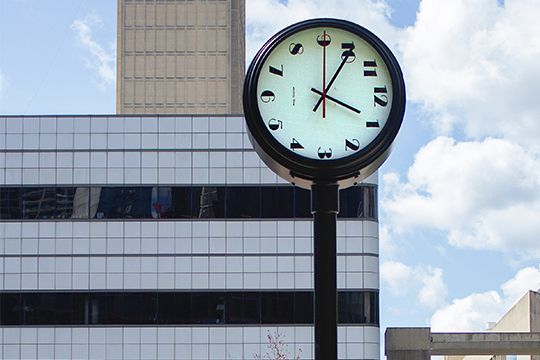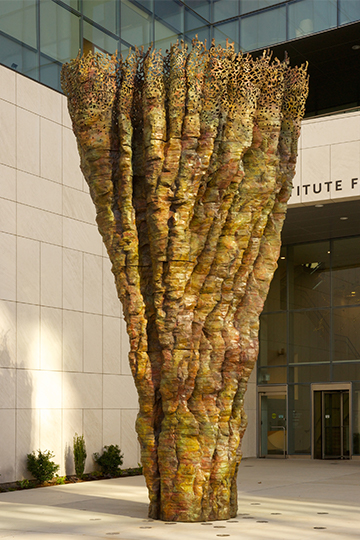 Shall we begin with Henry Moore? Moore's work was foundational to the Nasher’s collection and is also one of the more historic names in MIT’s public art collection, centrally sited at the heart of campus between the river and the campus’s iconic dome. Noting their shared titular and figurative allusions, it’s fun to see Moore’s investigation evolve between the Nasher’s Three Piece No. 3: Vertebrae (1968) and Three-Piece Reclining Figure, Draped, (1976) eight years later. Moore was inspired by pre-Columbian Chacmool sculptures of rain deities from the Yucatán region of Mexico, an apt reference in rainy Boston, and mere steps from the always animate Charles River.
Shall we begin with Henry Moore? Moore's work was foundational to the Nasher’s collection and is also one of the more historic names in MIT’s public art collection, centrally sited at the heart of campus between the river and the campus’s iconic dome. Noting their shared titular and figurative allusions, it’s fun to see Moore’s investigation evolve between the Nasher’s Three Piece No. 3: Vertebrae (1968) and Three-Piece Reclining Figure, Draped, (1976) eight years later. Moore was inspired by pre-Columbian Chacmool sculptures of rain deities from the Yucatán region of Mexico, an apt reference in rainy Boston, and mere steps from the always animate Charles River.
Head east along Memorial Drive (passing Nasher collection artist Jacques Lipchitz’s Birth of the Muses (1944-50) until you see Alexander Calder’s gigantic La Grande Voile (The Big Sail) (1965) on your left, the monumental centerpiece of a courtyard in the distance. Once you’re close enough to walk between its curvy legs, look back on a sunny day and you’ll likely spy much smaller, white sails darting around the river in the distance as well as the syncopated flickerings of cars and runners, all framed by the odd silhouettes cut by Calder’s static behemoth—what he called a ‘stabile.’ Head one courtyard further east to set it into dialogue with Louise Nevelson’s Transparent Horizon (1975). Although it is another black, welded metal monolith, these two are strikingly different. Whereas Calder’s Sail makes as much sense from any angle, Nevelson’s Horizon has two distinct sides like a quizzical fence, echoing the frontality and plays of relief typical of her well-known wooden assemblages.
 Nevelson’s Horizon was the first of many works supported by MIT’s Percent-for-Art Program, administered by the nearby List Visual Arts Center, located just across Ames Street (in a building designed by I.M. Pei). The List curates the public art collection, the campus gallery, and its temporary exhibitions, as well as off-site projects such as MIT Professor Emerita Joan Jonas’s They Come to Us Without a Word for the Venice Biennale 2015. The Percent-for-Art Program currently dedicates up to $500,000 to the creation of commissioned artworks for every major renovation or new campus construction project at MIT. The program originated in 1968, arguably formalizing the spirit of collaboration demonstrated by earlier initiatives such as the MIT Chapel (1954) designed by architect Eero Saarinen with an exoskeletal bell tower by sculptor Theodore Roszak and hovering altar screen by sculptor Harry Bertoia.
Nevelson’s Horizon was the first of many works supported by MIT’s Percent-for-Art Program, administered by the nearby List Visual Arts Center, located just across Ames Street (in a building designed by I.M. Pei). The List curates the public art collection, the campus gallery, and its temporary exhibitions, as well as off-site projects such as MIT Professor Emerita Joan Jonas’s They Come to Us Without a Word for the Venice Biennale 2015. The Percent-for-Art Program currently dedicates up to $500,000 to the creation of commissioned artworks for every major renovation or new campus construction project at MIT. The program originated in 1968, arguably formalizing the spirit of collaboration demonstrated by earlier initiatives such as the MIT Chapel (1954) designed by architect Eero Saarinen with an exoskeletal bell tower by sculptor Theodore Roszak and hovering altar screen by sculptor Harry Bertoia.
Rounding the list, you’ll see another, more orthopedic Henry Moore (Reclining Figure, 1963), and Alicja Kwade’s Against the Run (2019), a clock whose numbers move as much as its hands. Look closely and you’ll see that despite its anxious rotation, this clock still keeps perfect time. Find Amherst Street and follow it northeast until you arrive at the MIT Sloan School of Management, and Cai Guo-Qiang’s Ring Stone (2010). Well known for his firework performances and paintings, Guo-Qiang cut the 12 rings (one for each zodiac animal and month of the lunar calendar) from a single, 14 metric ton block of white granite from the caves of Zhangbanzhen near the artist’s hometown of Quanzhou. Japanese black pine trees planted within the rings allude to classical Chinese landscape painting, and add a natural, ever-changing element.
Maybe after a spell in one of the Adirondack chairs popular in this courtyard, find Main Street and head west, until you arrive at Ursula von Rydingsvard’s SCIENTIA (2016), a tall tawny form dabbled with shades of brown, moss green, and rust. Well known for her often chainsaw-carved wooden forms, it’s fascinating to see von Rydingsvard’s abstract, gestural language (also on view outside Brooklyn’s Barclays Center) translated here into towering metal. The threat of a tornado is tempered by its simultaneous testament to the still permanence of a rocky cave, or even lace and honeycomb toward its uppermost edge.
 Circle around the Frank Gehry-designed Stata Center, and see if you can find Beverly Pepper’s Trinity (formerly Dunes I) (1971) tucked into a niche behind the Compton Laboratories like seals in a cove. Apprehend it with her Black Angel (1967) and Venezia Blu (1968)—both in the Nasher collection—in mind, and it’s clear that Pepper made a quick transition from polished to rusted Cor-Ten steel, anticipating the texture and earthbound profile of her Dallas Land Canal: Canal and Hillside (1971-75), a land artwork commissioned by Raymond and Patsy Nasher for NorthPark.
Circle around the Frank Gehry-designed Stata Center, and see if you can find Beverly Pepper’s Trinity (formerly Dunes I) (1971) tucked into a niche behind the Compton Laboratories like seals in a cove. Apprehend it with her Black Angel (1967) and Venezia Blu (1968)—both in the Nasher collection—in mind, and it’s clear that Pepper made a quick transition from polished to rusted Cor-Ten steel, anticipating the texture and earthbound profile of her Dallas Land Canal: Canal and Hillside (1971-75), a land artwork commissioned by Raymond and Patsy Nasher for NorthPark.
Now head west, finding your way between Vassar Street to the south and Albany Street to the north until you reach Pacific Street. Follow it north to our last stop, Sarah Sze’s Blue Poles (2004-06), a series of fire escapes built to the scale of a cat. Commissioned to decorate the exterior of a graduate student dorm, Sze’s sculpture captures the sometimes frantic, anxious feeling of student (or any) life. Arriving at it, hopefully you feel a sense of relief with no urge to flee.
Grant Johnson is a curator and writer based in Massachusetts and Ohio. Currently a Joan Tisch Teaching Fellow at the Whitney Museum of American Art, he completed a Ph.D. in art history at the University of Southern California in 2021. His work appears in Artforum and frieze, among other publications.
Photos, from top: Alicja Kwade, Against the Run, 2019. MIT Collection. Commissioned with MIT Percent-for-Art Funds with gifts from Robert D. (‘64) and Sara-Ann Sanders. Photography courtesy of MIT List Visual Arts Center. / Ursula von Rydingsvard, SCIENTIA, 2016. Bronze 300 x 150 x 120 in. (762 x 381 x 304.8 cm). A gift commissioned by Lore Harp McGovern for the McGovern Institute for Brain Research and the Public Art Collection of the Massachusetts. Photography by Jerry L. Thompson. / Sarah Sze, Blue Poles, 2004-06. Installation. Painted steel and aluminum 600 in. Commissioned with MIT Percent-for-Art Funds. Photography by George Bouret.